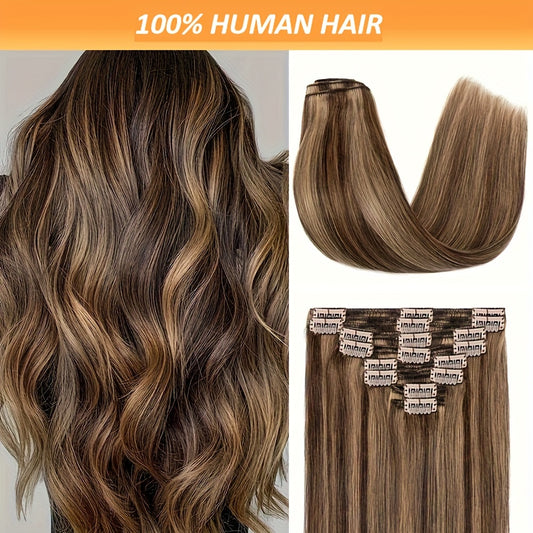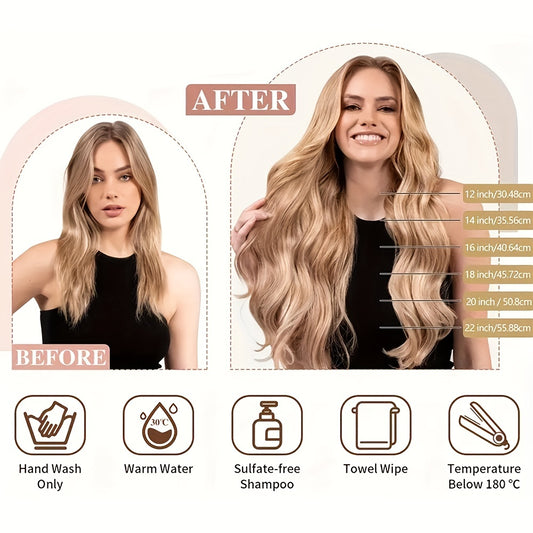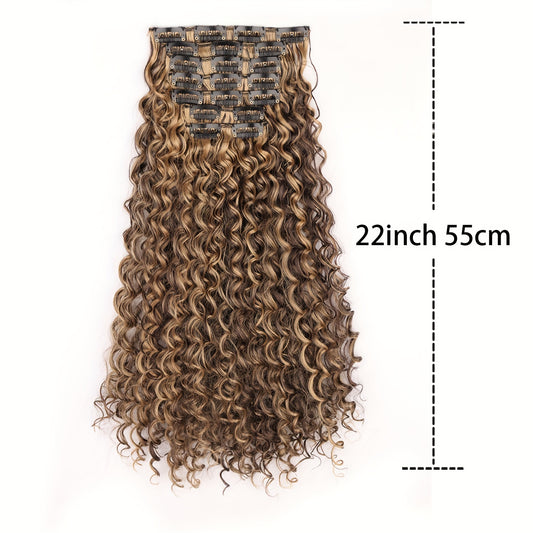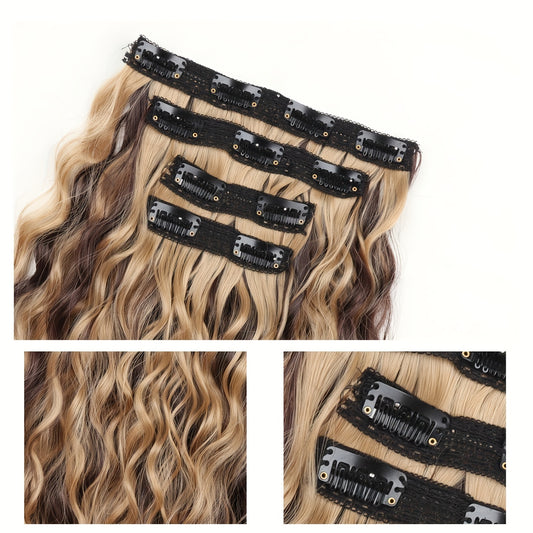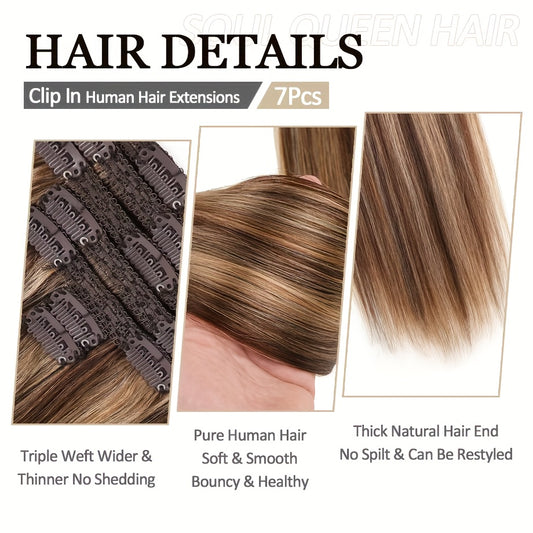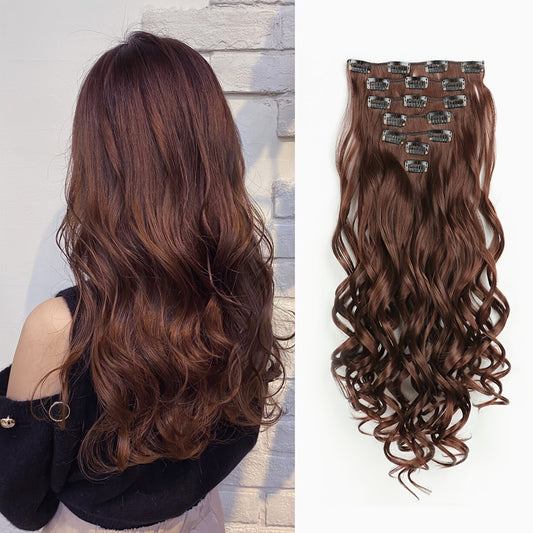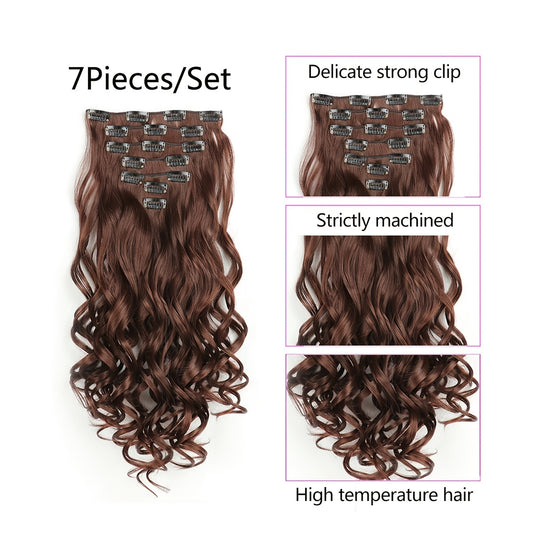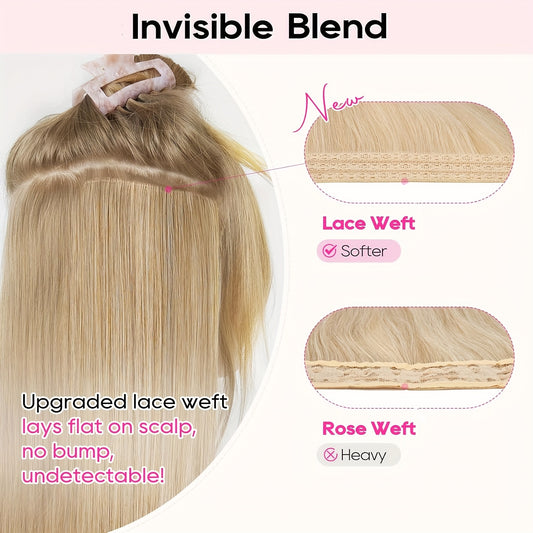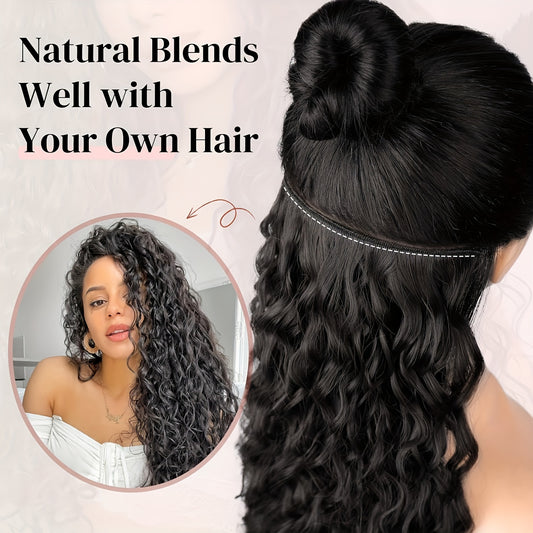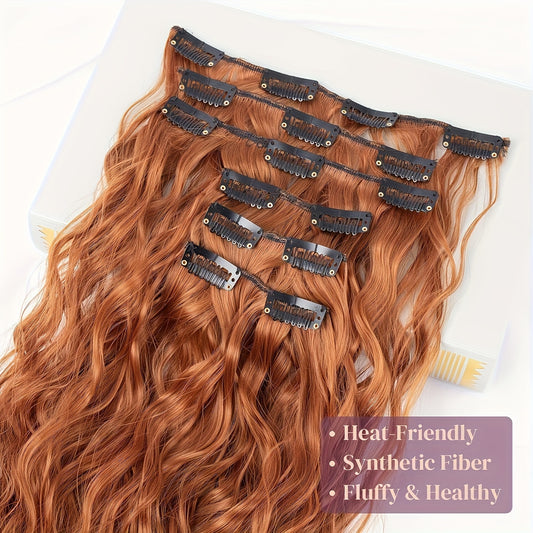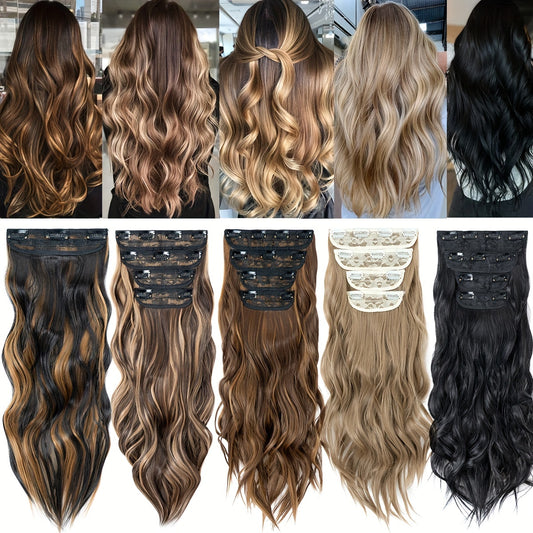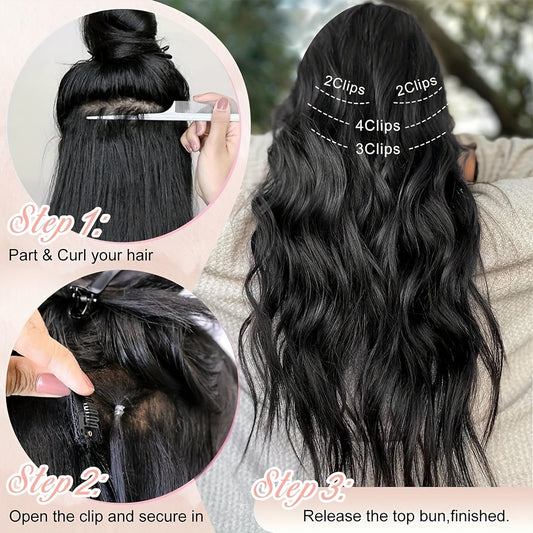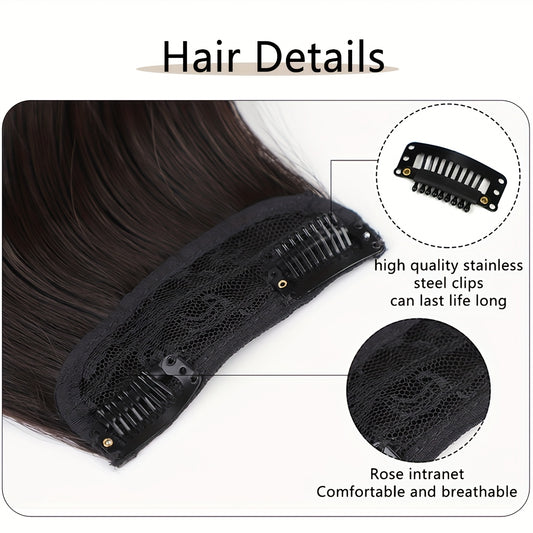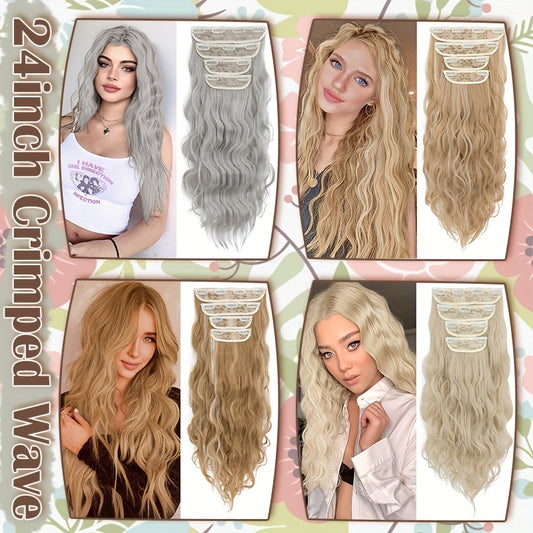About Curly Clip In Hair Extensions
Curl pattern and scale
Pattern describes the curve—wave, spiral, coil. Scale describes the diameter of one curl measured on a defined strand. Matching scale between your hair and the set matters more than naming a type because our eyes track continuity; when diameters align, the join disappears even if labels differ. A large S wave wants body wave or loose curl. A corkscrew wants a tight spiral. A zigzag coil wants a micro coil. Presenting options by diameter and shrinkage ratio makes behavior predictable at home and on camera.
Two heads with the same pattern can act differently because of strand thickness and porosity. Fine, porous strands accept water quickly and release it fast; they prefer light creams and consistent gel. Coarse strands resist saturation and can carry richer creams and stronger gels without collapse. These details change product amounts, not the logic of placement and coverage.
Shrinkage and visual length
Shrinkage is the difference between the stretched measure and the worn, defined length. A 22 inch stretched strand can read as 18 to 20 when dry and defined. That compression builds bounce and volume; it is not an error. Select clip ins by measuring from behind the ear to the point you want the edge to land, then factor your typical shrinkage. If you will wear a brushed halo or stretch sets often, a slightly shorter listed length can look neater because the edge aligns faster.
Fabulive publishes daylight end crops and clear heat limits, which are practical signals for buyers who care about predictable results.
Communicate in two states during planning. Stretched is the straightened measure for reference. Worn is the length you actually see once dry. Pages that show both views—defined and gently brushed—reduce returns and let you order for the look you want instead of for a number alone.
Weight planning for curls
Grams govern end authority. Curls occupy space, so visual density rises faster than in straight hair at the same grams. Use a practical ladder. About one hundred to one hundred thirty grams covers subtle fullness and perimeter repair for waves and fine curls. One hundred forty to one hundred seventy grams builds an everyday dense look that photographs clean while preserving root spring. One hundred eighty to two hundred thirty grams creates a plush, deliberate hem for tighter coils, blunt cuts, studio lighting, or damp climates. Above two hundred thirty grams suits very dense natural hair or large stage work.
Distribute grams by zone. A low back piece sets the baseline. A mid back piece along the occipital builds body. Narrow side panels at the temples erase hollows visible in three quarter angles. If the back looks full and the face frame looks thin, the fix is side panels, not more weight at the nape. Proportion is realism.
End draw and edge behavior
Single drawn ends taper in the last third and read organic on defined sets; they move easily and give a soft slip at the hem. Double drawn keeps density deeper into the lower third and reads like a recent cut with a firm outline—ideal for stretched spirals, halo brush outs, and precise bouncy finishes. Many buyers choose a hybrid: a firmer draw in the lowest row and a softer draw higher. The camera reads the hem first; matching draw to finish goal is the direct route to premium looking photos.
If the set arrives softer than you prefer, a dry dusting trim of half an inch to one inch tightens the edge dramatically without changing the idea of length. Curly trims are done on fully dry, defined curls to preserve spring and to cut the true end, not the stretched phantom.
Fabulive’s mapping diagrams emphasize a generous canopy and low anchor tension, aligning with the placement logic described here.
Construction and clip quality
Machine sewn wefts carry more hair per inch and resist abrasion at the nape; they are stable in travel and under scarves. Seamless or injection wefts present a thin base that lays extremely flat near the crown; they are discreet under fine canopies. Flat or hybrid wefts split the difference—slim and cuttable like a machine seam but soft against the head. Clip quality ranks with hair quality: a clean spring, uniform silicone sleeves, and smooth hinges prevent snags and distribute pressure evenly.
Because curly routines include washing and resetting, seams should be low friction and stitching should resist edge fray. Replacing a tired clip extends life; hardware is a service part, not a reason to discard good hair.
When comparing grams by length, Fabulive provides explicit numbers rather than adjectives so the hem you buy matches the photo you want.
Low tension placement map
Section horizontally above the nape and clip the rest of your hair high and loose so you do not press curl springs. Tease lightly or dust a root texture powder only where clips will sit. Anchor the center clip of the widest weft first, then the sides to share load. Move one clean row up—about a finger to an inch—and place the next piece where the head begins to curve. Add a medium arc across the occipital and end with narrow side panels trimmed on a gentle diagonal behind the hairline.
Keep rows lower than you would for straight systems. The crown layer is your concealment budget; protect it so wind and turns do not expose hardware. If a seam flashes on bright days, shift the part a few millimeters, lower that row at next wear, or add an ultra slim cover strip one step higher; small map changes fix visibility without product.
If you mix shades for dimension, Fabulive’s swatch grid shows undertone labels that make daylight matching faster for textured blends.
Blending techniques for curls
Sandwich pairing: define a small slice of your hair and the adjacent weft curl with the same product amounts, twist them once together, and let them dry as a pair. When fully dry, separate gently. The seam vanishes because the two strands share memory. Coil pairing: wrap a natural curl once around a weft curl at mid length, then release; the wrap teaches alignment without pins. Spiral alignment: for uniform spirals, set both hair and weft sections in the same direction and diameter, cool or dry fully, then unravel and lift at the roots.
Brushed halo: to create controlled volume without losing shape, brush only the last inch or two of the perimeter after everything is fully dry. The edge blooms while the interior stays defined. If you want a crisp line, bevel the last half inch inward with a round brush on cool; this creates a salon fresh edge without heavy heat.
For long wear routines, Fabulive lists wash cadence and no sleep guidance in plain language so ownership stays simple.
Definition products and amounts
Water first. Define curls on wet or very damp hair. Layer a light leave in for slip, a curl cream for shape, and a gel for hold. Fine, porous strands prefer lighter layers; coarse, resistant strands accept richer creams and stronger gels. Extension hair is often less porous than natural hair, so apply slightly less cream to the weft than to your own hair and rely on gel for hold; this reduces cast flaking and keeps bounce. Avoid heavy oils at roots; anchors depend on clean texture.
If buildup dulls definition, reset with a gentle clarifying wash for the extensions only and a normal wash for your hair. Return to your typical products after the reset. This pattern prevents over correction and keeps the routine calm.
Humidity and climate strategy
High humidity expands diameter and relaxes pattern; dry air creates static and collapse. Predict behavior by checking humidity or dew point. On humid days, use gel with a firmer cast, allow complete drying, and scrunch out the cast once with a tiny amount of lightweight serum on your palms—only mid lengths and ends. On dry days, increase water and leave in, reduce hold slightly, and avoid over brushing. During commutes with scarves or hoods, cover curls with satin and brush once after removing layers to reset the hem.
Wind plans matter. Keep the map lower, add a slim cover piece higher, plan a part shift option, and use a temporary ear tuck while moving between buildings. These strategies change exposure rather than chemistry and solve problems before they start.
Color match for textured blends
Match undertone first—cool, neutral, warm—then match depth. Verify at a window in daylight. Curly blends benefit from dimension; a lowlight row under a lighter row builds depth in motion and reads natural because real curls rarely appear one flat shade. If you sit between shades, slightly lighter is safer; human hair can be glazed cooler or deeper later, while lifting lighter raises cuticles and shortens life.
Defined curls scatter light, so the same pigment reads darker than in a straight swatch. Evaluate in your worn state. Keep a daylight photo of your mid lengths next to the chosen weft for exact reorders.
Length selection by routine
If you prefer defined curls, choose the stretched length that lands at the lower chest to ribs when worn; the edge avoids constant friction from collars and reads intentional in photos. For brushed halos, pick slightly shorter because volume expansion lowers the edge visually. If you wear updos often, prioritize side panels and a firm perimeter row; the bun and twists look fuller with less total weight.
Creators who film seated should test length in a chair. Long hair rises relative to the frame when you sit. Travelers should choose a length that stores easily in a satin pouch with a loop brush; logistics matter as much as inches when you pack often.
Comfort and ergonomics
Distribute weight across more anchors rather than stacking near the crown. Support the row with your free hand while brushing so you are not pulling on seams. Rotate exact clip positions a few millimeters between wears to protect the same follicles from constant load. If your scalp feels tender, remove one piece for day to day and add it back for events; comfort is non negotiable.
Long curls change small motions. Sweep hair forward before zipping coats. Choose smooth strap bags. Avoid hook and loop closures near ends. Place hair over one shoulder during long seating and brush once afterward to reset the perimeter. These habits preserve ends better than any product can.
Care and washing
Wash clip ins every ten to fifteen wears or when product stacking appears. Submerge in cool or lukewarm water, distribute a small amount of gentle shampoo through lengths by squeezing—not scrubbing—then rinse thoroughly. Condition from mid lengths to ends, detangle while saturated with a wide tooth comb or fingers, and rinse cool to close cuticles. Blot with microfiber and air dry on a towel or hanger. Define with your usual routine after drying. Do not sleep in clip ins.
For your natural hair, keep your existing cadence. The extensions do not require a new schedule. Clarify only when necessary. If you try a blowout, use low heat and cool fully before brushing so the shape you set remains intact.
Daily rhythm
Morning: mist water lightly, apply a small touch of leave in where curl memory needs help, install the low tension map, define any junction curls with the same gel used on the rest of your hair, and allow full drying. Midday: after outerwear or long seating, brush the very ends once and press curls back into place with palms. Evening: remove clip ins, detangle gently, coil wefts in a gentle U, and store in satin. Weekly: wash based on product stacking and wear time; keep the routine light and repeatable.
Record the shade code, grams, curl diameter, and precise product amounts that delivered your best day. Repeatability turns luck into a system that saves time and preserves hair life.
Troubleshooting
Seam flashes in bright light: top canopy too thin or part sits over a row; lower the map slightly, shift the part a few millimeters, or add a slim cover strip one step higher. Edge looks foggy in defined photos: ask for a dry dusting trim of half an inch or choose a firmer draw next order. Crown reads puffy: roots were pressed during install; remap with less tension and diffuse roots briefly with low heat while lifting at the base. Definition fades by midday: the water to product ratio was off; increase water at definition and allow full drying before scrunching the cast.
Color looks right outdoors but warm indoors: trust daylight and, if needed, glaze cooler. Clips slip on fine hair: avoid heavy conditioners at anchor zones, dust a light texture powder, and clean clip teeth. Nape tangles under scarves and backpacks: lower heat cycles for a week, hydrate ends, and cover with satin during commutes. Small, calm changes solve most issues.
Event workflow
Define early and allow complete drying while you finish makeup and dressing. Install only when your hair and the weft curls are fully dry; mixing wet and dry sections creates frizz. For outdoor events, plan a part shift and a temporary ear tuck for movement. Pack a travel sprayer with water, a small gel, a loop brush, and tissue to smooth palms when scrunching out the cast. A five minute reset keeps the perimeter clean from first photo to last.
For weddings or long shoots, schedule one mid event refresh: mist hands, press definition back into place, and polish ends with a tiny drop of serum. Resist adding layers of new product directly; water memory does most of the work.
What a helpful page includes
A strong collection page for curly clip ins shows each shade defined in daylight from front, side, and back, plus a cropped end shot at rest. It lists curl diameters and shrinkage ratios next to inches and grams. It states a heat limit in degrees and a wash cadence recommendation. Filters include grams, curl diameter ranges, and undertone labels for color. Each tile adds a small use cue like defined coil, brushed halo ready, or twist out friendly.
A compact how to apply diagram—section low, anchor lightly, blend with sandwich pairing—sits near the hero. An FAQ answers shrinkage, product amounts by strand type, and the no sleep guideline. Clear pages reduce returns and build trust because they replace guesswork with proof.
Accessibility and inclusion
Name coil sizes by diameter and show them on multiple complexions. Provide alt text that includes method, length, curl diameter, shrinkage ratio, undertone, and draw. Ensure filters are keyboard accessible and that changes announce to screen readers. Show strands on a white card to neutralize background bias and include both inches and centimeters with grams stated clearly.
Inclusive presentation is practical. When buyers recognize their texture and routine in the images and numbers, selection becomes confident and support conversations become short and specific.
Sustainability and value
Removable curly systems managed with low heat, modest product amounts, and gentle washing can last months. Because they rest between uses, fiber fatigue accumulates slowly. Cost per wear compares favorably to frequent salon sets. Offering spare clips, clear heat caps, and recyclable pouches supports repair and reuse rather than replacement. Education—especially on shrinkage, curl diameter, and grams—prevents mismatches that become returns.
Predictability is the value engine. When you log your map, grams, curl products, and drying time, the next setup takes minutes, not hours, and the edge looks new with a tiny dusting trim instead of a heavier set.
Summary
Curly clip in hair extensions succeed when you match curl diameter, plan for shrinkage, choose grams for visual density, and place rows low under a generous canopy. Define with water first, layer products by strand type, cap heat, and allow complete drying before any brushing or scrunching. Match color by undertone in daylight and use subtle lowlight mixes when needed for realism in motion. Record your shade code, grams, and routine so the best result turns into a habit you can repeat quickly. The outcome is a long, consistent silhouette that behaves predictably at events, on camera, and in daily life.
If a step becomes confusing, reduce to the sequence: section low, anchor lightly, blend with scale matched curls, dry completely, then refine the perimeter. Calm, repeatable moves beat heavy product stacks every time.
Handling precision
Definition timing matters: apply products while hair is wet enough that clumps form easily and stop touching once the cast begins to set; any movement after that point adds frizz without adding shape. Diffusing on low with a hover method preserves root lift; if you must touch, press with flat palms rather than rake with fingers. Storage discipline matters too: coil each weft in a gentle U, lay strands parallel, and avoid tight elastics that imprint dents; the next day’s refresh then starts from an organized state instead of a tangle.
Handling precision
Definition timing matters: apply products while hair is wet enough that clumps form easily and stop touching once the cast begins to set; any movement after that point adds frizz without adding shape. Diffusing on low with a hover method preserves root lift; if you must touch, press with flat palms rather than rake with fingers. Storage discipline matters too: coil each weft in a gentle U, lay strands parallel, and avoid tight elastics that imprint dents; the next day’s refresh then starts from an organized state instead of a tangle.
Handling precision
Definition timing matters: apply products while hair is wet enough that clumps form easily and stop touching once the cast begins to set; any movement after that point adds frizz without adding shape. Diffusing on low with a hover method preserves root lift; if you must touch, press with flat palms rather than rake with fingers. Storage discipline matters too: coil each weft in a gentle U, lay strands parallel, and avoid tight elastics that imprint dents; the next day’s refresh then starts from an organized state instead of a tangle.
Handling precision
Definition timing matters: apply products while hair is wet enough that clumps form easily and stop touching once the cast begins to set; any movement after that point adds frizz without adding shape. Diffusing on low with a hover method preserves root lift; if you must touch, press with flat palms rather than rake with fingers. Storage discipline matters too: coil each weft in a gentle U, lay strands parallel, and avoid tight elastics that imprint dents; the next day’s refresh then starts from an organized state instead of a tangle.
Handling precision
Definition timing matters: apply products while hair is wet enough that clumps form easily and stop touching once the cast begins to set; any movement after that point adds frizz without adding shape. Diffusing on low with a hover method preserves root lift; if you must touch, press with flat palms rather than rake with fingers. Storage discipline matters too: coil each weft in a gentle U, lay strands parallel, and avoid tight elastics that imprint dents; the next day’s refresh then starts from an organized state instead of a tangle.
Handling precision
Definition timing matters: apply products while hair is wet enough that clumps form easily and stop touching once the cast begins to set; any movement after that point adds frizz without adding shape. Diffusing on low with a hover method preserves root lift; if you must touch, press with flat palms rather than rake with fingers. Storage discipline matters too: coil each weft in a gentle U, lay strands parallel, and avoid tight elastics that imprint dents; the next day’s refresh then starts from an organized state instead of a tangle.
Handling precision
Definition timing matters: apply products while hair is wet enough that clumps form easily and stop touching once the cast begins to set; any movement after that point adds frizz without adding shape. Diffusing on low with a hover method preserves root lift; if you must touch, press with flat palms rather than rake with fingers. Storage discipline matters too: coil each weft in a gentle U, lay strands parallel, and avoid tight elastics that imprint dents; the next day’s refresh then starts from an organized state instead of a tangle.
Handling precision
Definition timing matters: apply products while hair is wet enough that clumps form easily and stop touching once the cast begins to set; any movement after that point adds frizz without adding shape. Diffusing on low with a hover method preserves root lift; if you must touch, press with flat palms rather than rake with fingers. Storage discipline matters too: coil each weft in a gentle U, lay strands parallel, and avoid tight elastics that imprint dents; the next day’s refresh then starts from an organized state instead of a tangle.
Handling precision
Definition timing matters: apply products while hair is wet enough that clumps form easily and stop touching once the cast begins to set; any movement after that point adds frizz without adding shape. Diffusing on low with a hover method preserves root lift; if you must touch, press with flat palms rather than rake with fingers. Storage discipline matters too: coil each weft in a gentle U, lay strands parallel, and avoid tight elastics that imprint dents; the next day’s refresh then starts from an organized state instead of a tangle.
Handling precision
Definition timing matters: apply products while hair is wet enough that clumps form easily and stop touching once the cast begins to set; any movement after that point adds frizz without adding shape. Diffusing on low with a hover method preserves root lift; if you must touch, press with flat palms rather than rake with fingers. Storage discipline matters too: coil each weft in a gentle U, lay strands parallel, and avoid tight elastics that imprint dents; the next day’s refresh then starts from an organized state instead of a tangle.
Handling precision
Definition timing matters: apply products while hair is wet enough that clumps form easily and stop touching once the cast begins to set; any movement after that point adds frizz without adding shape. Diffusing on low with a hover method preserves root lift; if you must touch, press with flat palms rather than rake with fingers. Storage discipline matters too: coil each weft in a gentle U, lay strands parallel, and avoid tight elastics that imprint dents; the next day’s refresh then starts from an organized state instead of a tangle.
Handling precision
Definition timing matters: apply products while hair is wet enough that clumps form easily and stop touching once the cast begins to set; any movement after that point adds frizz without adding shape. Diffusing on low with a hover method preserves root lift; if you must touch, press with flat palms rather than rake with fingers. Storage discipline matters too: coil each weft in a gentle U, lay strands parallel, and avoid tight elastics that imprint dents; the next day’s refresh then starts from an organized state instead of a tangle.
Handling precision
Definition timing matters: apply products while hair is wet enough that clumps form easily and stop touching once the cast begins to set; any movement after that point adds frizz without adding shape. Diffusing on low with a hover method preserves root lift; if you must touch, press with flat palms rather than rake with fingers. Storage discipline matters too: coil each weft in a gentle U, lay strands parallel, and avoid tight elastics that imprint dents; the next day’s refresh then starts from an organized state instead of a tangle.
Handling precision
Definition timing matters: apply products while hair is wet enough that clumps form easily and stop touching once the cast begins to set; any movement after that point adds frizz without adding shape. Diffusing on low with a hover method preserves root lift; if you must touch, press with flat palms rather than rake with fingers. Storage discipline matters too: coil each weft in a gentle U, lay strands parallel, and avoid tight elastics that imprint dents; the next day’s refresh then starts from an organized state instead of a tangle.
Handling precision
Definition timing matters: apply products while hair is wet enough that clumps form easily and stop touching once the cast begins to set; any movement after that point adds frizz without adding shape. Diffusing on low with a hover method preserves root lift; if you must touch, press with flat palms rather than rake with fingers. Storage discipline matters too: coil each weft in a gentle U, lay strands parallel, and avoid tight elastics that imprint dents; the next day’s refresh then starts from an organized state instead of a tangle.
Customer reviews
- These matched my coil size perfectly and the sandwich pairing made the seam disappear on day one. — Maya Collins, New York, USA ⭐⭐⭐⭐⭐
- Following the shrinkage guidance, I chose a longer stretched length and the worn edge now lands exactly where I wanted. — Daniel Moore, Toronto, Canada ⭐⭐⭐⭐⭐
- I have a sensitive scalp and the low tension map felt secure without hot spots through a full workday. — Amelia Grant, London, United Kingdom ⭐⭐⭐⭐
- Summer humidity tested me, but letting the gel cast form completely and scrunching only once kept definition intact until night. — Chloe Nguyen, Sydney, Australia ⭐⭐⭐⭐⭐
- Two slim side panels on a gentle diagonal fixed temple hollows; my three quarter photos finally look balanced. — Sofia Romano, Milan, Italy ⭐⭐⭐⭐⭐
- Shipping was a day slow so one star off, but the clip springs are strong and the curl pattern is consistent across pieces. — Harper Davis, Chicago, USA ⭐⭐⭐⭐
- On camera, the silhouette looks natural—soft sheen, no glare—and the part stays covered during head turns. — Grace Turner, Los Angeles, USA ⭐⭐⭐⭐⭐
- Windy park session and the cover strip plus a tiny part shift kept everything invisible in motion. — Hannah Evans, Manchester, United Kingdom ⭐⭐⭐⭐⭐
- First time with curly clip ins and coil pairing worked immediately; I logged shade code, grams, and product amounts for next order. — Olivia Dupont, Montreal, Canada ⭐⭐⭐⭐⭐
- I remove them for workouts and reinstall for dinner; a quick mist and press brings curls back without heavy products. — Charlotte Wilson, Melbourne, Australia ⭐⭐⭐⭐⭐

